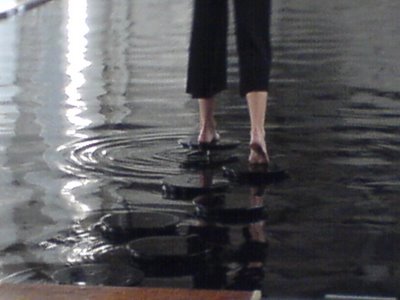Bridge

A sheet of water is sitting in front of me, it is black, still and shiny. This is no ordinary body of water. Bound on three sides by the walls of the disused chapel of Dilston Grove is the tank constructed by designer Michael Cross that contains his latest mechanical experiment. It is an act of trust, faith or resignation to the effects of failure coupled with boldness in accepting the consequences of your actions.
Directly in front of me is a ramp centrally located to one edge of the tank of water, somebody ascends the gentle ramp and with trousers rolled to mid calf and bare footed steps onto a small disk that barely breaks the surface of the water in front of their feet, they step onto the disk and as the pressure of their weight bears onto this small step another gently rotates to the surface of the water allowing their other foot to step in front. This action is repeated for many steps as they gently, quietly, calmly and with small modifications of balance make their progress walking out into the middle of the water. At the final step the person turns slowly and returns along the disks to their point of embarkation.
This is the scene observed by the many people entering this quietly impressive but calming space, it is cavernous but welcoming, dark with gentle evening sunlight breaking through the high windows that intersect the walls. The black pigmented water shimmers and the ripples created by the movement of feet soon subside into stillness on the water as the person walking stops, balances and contemplates their next step.
Michael Cross has created an installation that embraces the site. Initially all viewers and participants in the experience unfolding in Dilston Grove are slowly induced into tension, contained excitement and expectation. Once the first few steps have been taken we are all tuned to the movements of the person in the water, our senses pick up every signal being sent back across the water to us, every twitch of muscle in their neck, every small balancing motion transferred through their arms and out to the fingertips and every minor shuffle, lift and lowering of their bare feet. For the person exposed on their steps out into the water the viewing public fade as their concentration on their task allows other stimuli to recede, they continue the process of emotional and physical isolation the task demands. The consequence of failure is to descend into the water, of course this is never going to happen. This is the small child in the playground pretending to do the high wire walk whilst still on firm ground, the act and action becomes real, the fiction becomes fact. In the water the outward journey is complete and they return and with their slow walk back we and they begin to reconnect, out of the water the relief becomes complete, they are back, the isolation is over, the water is still and the act complete.

0 Comments:
Post a Comment
Subscribe to Post Comments [Atom]
<< Home